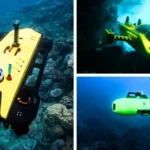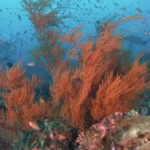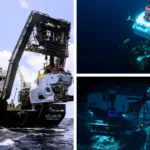The deep sea, a vast and mysterious realm beneath the ocean’s surface, is home to many extraordinary and otherworldly creatures. These deep-sea dwellers, adapted to survive in extreme conditions of darkness, pressure, and cold, continue to captivate scientists and enthusiasts alike. In this article, we embark on a fascinating journey to explore the mysterious world of deep-sea creatures, shedding light on their unique adaptations, biodiversity, and the importance of understanding these enigmatic inhabitants of the abyss.
The Depths of Adaptation
Deep-sea creatures have evolved an array of remarkable adaptations to thrive in the harsh and extreme conditions of the abyss.
Bioluminescence
One of the most captivating adaptations of deep-sea creatures is bioluminescence. Many organisms in the deep sea, from jellyfish and squids to fish and crustaceans, produce their light through chemical reactions. Bioluminescence serves various purposes, including attracting mates, deterring predators, and luring prey into the darkness of the deep ocean.
Gigantism and Miniaturization
In the deep sea, creatures often display extreme size differences compared to their shallow-water counterparts. Some deep-sea organisms, like the colossal squid and the giant tube worm, have evolved to reach enormous sizes, while others, such as certain anglerfish and amphipods, have become miniaturized. These adaptations help them survive in the nutrient-limited deep-sea environment.
Pressure Tolerance
Due to the weight of the water above, the deep sea exerts immense pressure. Deep-sea creatures have developed specialized adaptations to withstand these extreme pressures, including flexible skeletons, gelatinous bodies, and unique cellular structures. These adaptations allow them to thrive in environments where human-made submarines can barely withstand the conditions.
Biodiversity in the Abyss
The deep sea harbors a diverse array of life forms, each uniquely adapted to its specific niche in this vast and unexplored ecosystem.
Abyssal Zone
The abyssal zone, extending from depths of 4,000 to 6,000 meters (13,000 to 20,000 feet), is home to a variety of creatures such as giant isopods, deep-sea corals, and elusive dumbo octopuses. The pitch-black darkness and frigid temperatures create a challenging environment, yet these organisms have evolved to thrive in this extreme habitat.
Hadal Zone
Even deeper than the abyssal zone lies the hadal zone, which includes the deepest ocean trenches on Earth. Despite the intense pressures and lack of sunlight, the hadal zone is home to unique organisms like amphipods, giant sea cucumbers, and the elusive hadal snailfish. These creatures have developed adaptations to survive in the extreme conditions of the trenches.
Hydrothermal Vent Communities
Hydrothermal vents, found along mid-ocean ridges, create oases of life in the deep sea. These vents release mineral-rich, superheated water, supporting vibrant ecosystems of tube worms, giant clams, and other extremophiles. These organisms rely on chemosynthesis, a process where bacteria convert chemicals from the vent fluids into energy, forming the basis of a unique food web.
Importance of Deep-Sea Exploration
Deep-sea exploration is crucial for advancing scientific knowledge, understanding biodiversity, and unlocking the secrets of Earth’s largest and least-explored habitat.
Biotic and Abiotic Interactions
Studying deep-sea creatures allows scientists to unravel complex ecological relationships and understand how organisms interact with each other and their environment. These interactions contribute to the cycling of nutrients, influence global ocean currents, and impact the health of the entire ocean ecosystem.
Biotechnological Discoveries
Deep-sea organisms have the potential to yield valuable biotechnological discoveries. Enzymes and compounds produced by deep-sea creatures adapted to extreme conditions may have applications in medicine, industry, and environmental monitoring. Bioprospecting in the deep sea could lead to the development of novel drugs and technologies.
Climate Change Indicators
The deep sea regulates Earth’s climate, sequesters carbon, and influences ocean circulation. Understanding the impact of climate change on deep-sea ecosystems is crucial for predicting how these habitats may change over time and assessing the potential consequences for global climate systems.
Conservation Challenges
Despite their ecological significance, deep-sea creatures face threats from human activities, including mining, overfishing, and climate change.
Deep-Sea Mining
Interest in deep-sea mining for valuable minerals poses a significant threat to the delicate ecosystems of the abyss. Extracting minerals from the seafloor can destroy habitats, create sediment plumes, and disturb deep-sea communities, jeopardizing the unique biodiversity found in these regions.
Overfishing and Bycatch
Deep-sea fisheries, targeting species like orange roughy and deep-sea sharks, can lead to overfishing and unintended bycatch of non-target species. The slow growth and low reproductive rates of many deep-sea organisms make them particularly vulnerable to exploitation, and overfishing can have lasting impacts on these populations.
Climate Change Effects
Climate change threatens deep-sea ecosystems, impacting temperature, ocean acidification, and oxygen levels. These environmental factors can affect the distribution and behavior of deep-sea creatures, potentially leading to shifts in community structures and the loss of important habitats.
Conclusion
Exploring the ocean’s depths unveils a world of wonders where deep-sea creatures defy expectations and showcase the resilience of life in extreme conditions. As scientists delve into the abyss’s mysteries, the importance of preserving these ecosystems becomes increasingly evident. Through responsible exploration, conservation efforts, and global cooperation, we can ensure the protection of these extraordinary creatures and the invaluable habitats they inhabit, fostering a deeper understanding of Earth’s interconnected marine environments.












